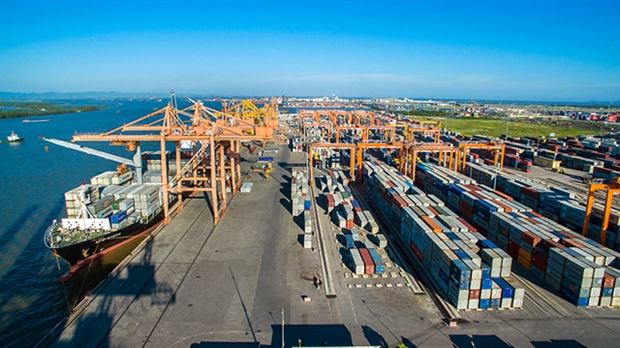
Containers loaded up at Dinh Vu Port in nothern city of Hai Phong. (Photo: VNA)
Revenue from tariffs and taxes has decreased by 13 trillion VND (475 million USD) compared to the same period last year. However, the ministry said earlier forecasts for net revenue to reach 340 trillion USD by the end of the year remained unchanged.
Le Manh Hung, deputy head of Vietnam Customs’s tax department, said import/export taxes were not the only revenue source as goods were also subject to other regimes including special consumption taxes, value-added taxes, anti-dumping duties and environmental protections taxes, among others.
“FTAs only require the removal of import taxes. For goods subject to multiple tax regimes, only import taxes will be lifted,” said Hung.
There had been a steady decrease in revenue from import taxes in recent years, according to a report by the customs authority, which resulted in smaller contribution to State revenue. Import tax revenue in 2018 dropped by 29 trillion VND and contributions to the State revenue ratio shrank by 4.4 percent in comparison to the previous year.
Net revenue from customs agencies, however, has been steadily rising with last year’s total figure reaching 314 trillion VND and this year’s forecast at 340 trillion VND. The year’s total figure also depends on import/export activities.
In addition, increased revenue from the domestic market had helped offset the falling income from import taxes, said Ha Duy Tung, deputy head of international trade cooperation at the finance ministry.
“Furthermore, Vietnam has been taking a proactive approach to start negotiations with major economic partners to take full advantage of its export markets,” said Tung.
Vietnam has become a signatory of or in the process of joining 20 trade agreements with countries and economies around the world.
So far, 12 FTAs had gone into effect with the Regional Comprehensive Economic Partnership (RCEP), one of the world’s largest free trade agreements, likely to reach a conclusion in the near future, said Tran Thi Thu Huyen, a representative from the ministry.
Proposals to slash import taxes and tariffs for imported goods under these FTAs have been submitted to the Government to implement.
Notably, a road map to remove tariffs for imported goods from ASEAN countries was completed in 2018.
With regards to the Comprehensive and Progressive Agreement for Trans-Pacific Partnership (CPTPP) signed in 2018, Vietnam is set to remove export tariffs for its goods in the next 5-15 years, with the exceptions of a number of important imports including crude oil, coal and gold.
The country had also set a target to reduce import tariffs to 0 percent on 86.5 percent of imported goods by 2022 with a plan to increase this figure to 97.8 percent by 2029, according to the ministry./.
VNA
 Speed up compensation, site clearance, and investment attraction in industrial parks
Speed up compensation, site clearance, and investment attraction in industrial parks



